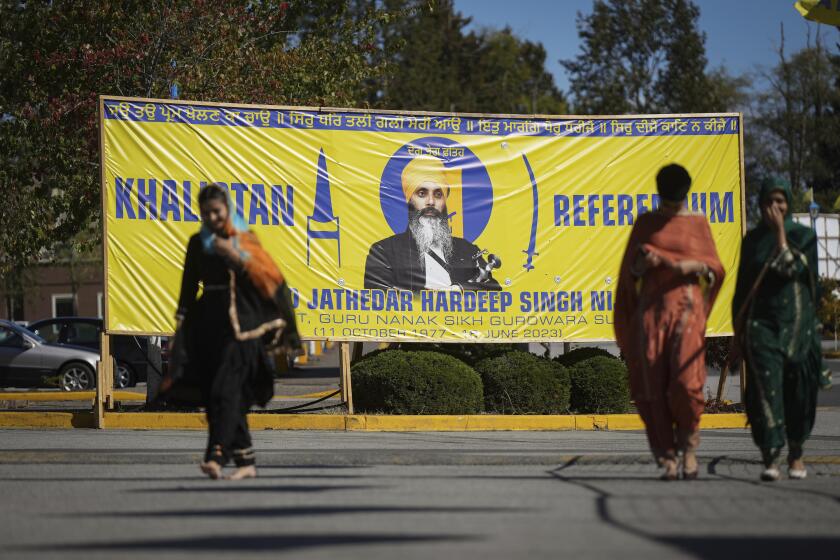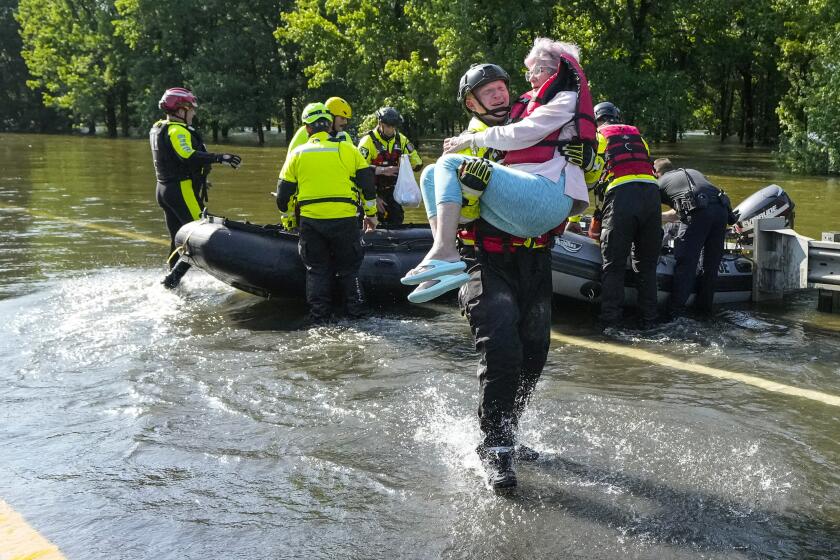If Hussein Is Really Dead, Where’s the Proof?
Under a smoking mound of rubble in what was once a Baghdad building lies a conundrum for U.S. military officials: What if they did their job of targeting Saddam Hussein too well?
As long as Hussein’s supporters believe there is a chance he is alive, some are sure to continue to fight for him, prolonging the war. And yet U.S. officials, by conducting a massive bombing strike on a building thought to house the Iraqi leader, may have disfigured Hussein’s body beyond recognition and deprived them of clear proof of his death.
“People are not going to believe Saddam Hussein is gone until there’s indisputable evidence,” said Rachel Bronson, director of Middle East studies at the Council on Foreign Relations. And if Iraqis continue to live in fear of him and his regime, “the hope of moving forward will be slowed down.”
U.S. intelligence officials said Tuesday that it remains unclear whether Hussein was killed or injured in the strike Monday, in which a U.S. warplane dropped four 2,000-pound bombs on a building where the Iraqi leader and his two sons were thought to be. The site remained under Iraqi control Tuesday, and it was uncertain when or whether U.S. forces would try to make their way to the scene. The site was covered with mounds of broken concrete, twisted iron rods, uprooted trees and splintered furniture. Rescue workers reported pulling three bodies from the wreckage, including those of a small child and an elderly man.
An official also said the CIA believes the intelligence behind the attack was solid. “There was a report that he and his sons and a number of senior Iraqi intelligence officials were there,” the official said. “That was reliable enough to justify the strike.”
One U.S. intelligence official said the target of the attack was a building near the Al Saa restaurant in the Mansour district of the city, an area of shops, homes and restaurants. The official declined to describe the nature of the building hit, but said there was no indication that there was an underground bunker at the site. In television pictures, the site appeared to have been turned into a pile of rocks.
Although the fate of the Iraqi leader remains unclear, the bombing raised the prospect that the U.S. coalition may kill Hussein without knowing for certain -- and without being able to prove to the world -- that he is dead. Hussein could be killed behind enemy lines, or his body disfigured beyond recognition.
DNA testing has improved recently as a result of the challenge of identifying victims of the World Trade Center attacks. But to prove that an unidentified body is that of the Iraqi leader, U.S. officials would need to obtain a sample from the body and compare it to DNA they are sure came from Hussein or from one of his close relatives.
Tissue samples do not need to be large in order to be useful. After the World Trade Center attacks, human tissue the size of a pencil eraser yielded information that led to identification -- even after the tissue was singed by fire, buried by rubble and covered in water for weeks.
“We have no reason to believe the samples from that crater in Baghdad will be in any worse shape than those retrieved from the World Trade Center,” said Mark Stolorow, executive director of Orchid Cellmark, a Maryland company that conducted DNA testing on victims of the Sept. 11, 2001, attacks. “If the sample is large enough to see, then it’s going to be large enough to test.”
At least 600 victims of the terrorist attack in New York were identified by DNA alone, Stolorow said. To make the identification, the samples were sometimes compared with genetic material on toothbrushes, clippings from razors, cigarette butts and even drinking straws provided by family members.
But it is unclear whether U.S. officials have any similar material they could use to identify tissue retrieved from the Baghdad bombing site.
One U.S. official said Tuesday that the United States does not have genetic material from Hussein himself.
Asked whether the United States has DNA samples from relatives of the Iraqi dictator, a second U.S. intelligence official said, “As far as I know, no.”
Judith Yaphe, former chief CIA analyst on Iraq and now a senior research fellow at the Institute of National Strategic Studies, said that at least three close relatives of Hussein were known to have traveled out of Iraq in the past, but that it was unclear whether DNA had been obtained from any of them.
One of Hussein’s half brothers, with whom he shares a mother, lived in Geneva for several years and apparently still has grown children in Switzerland. Hussein’s two oldest daughters, Raghad and Rana, defected to Jordan in 1995 with their husbands, who later returned to Iraq and were killed.
Raghad and Rana, along with a third daughter, Hala, appear to be alive today. According to some reports, the sisters fled to Syria before the start of the coalition bombing campaign in Baghdad.
Stolorow said that with genetic material from a son or daughter, a DNA sample could be shown with 90% certainty to have come from Hussein.
“You could make a strong case that an unknown sample was the parent of a known son or daughter -- a strong but not absolutely convincing case,” said Dr. David Valle, a professor at Johns Hopkins University and president of the American Society of Human Genetics. He said an identification could also be made with reasonable certainty from one of Saddam’s grandchildren.
John Pike, a military analyst with GlobalSecurity.org, a nonprofit agency that focuses on international security issues, said the people killed in the Baghdad raid Monday should be identifiable.
“They would not be vaporized,” Pike said. “There would be a large number of small pieces. How large the number would be, and how small the pieces would be, would depend on where the people were located and where the bombs detonated.”
To learn the fate of Hussein, U.S. spy agencies are also closely monitoring communications traffic in Baghdad for “chatter” among senior Iraqi officials and commanders that might indicate whether Hussein was killed or injured.
But a U.S. official said Tuesday that there was “no chatter one way or another” after the bombing.
Defense Secretary Donald H. Rumsfeld and other Pentagon officials have been trying to downplay the importance of capturing or killing Hussein, saying the goal of regime change goes beyond any individual. But many people in the Pentagon and the intelligence community believe it will be important to prove to the Iraqi people that Hussein is dead or in custody, largely because of his psychological grip on the population.
Paul Wolfowitz, the deputy secretary of Defense, said Sunday that “the best thing would be to know that he’s gone.”
But he also said: “The regime needs to be dismantled, and not just Saddam Hussein but the structures of terror. But I think the way to measure that, really, is when the fear goes away, and we’ll know that.”
*
Times staff writers Ricardo Alonso-Zaldivar, Robert Lee Hotz, Paul Richter and Bob Drogin contributed to this report.
More to Read
Start your day right
Sign up for Essential California for news, features and recommendations from the L.A. Times and beyond in your inbox six days a week.
You may occasionally receive promotional content from the Los Angeles Times.






